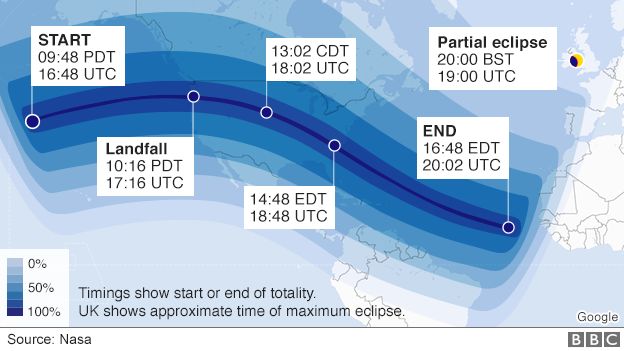The Great American Eclipse is under way.
A huge shadow cast by the Moon as it passes in front of the Sun has just touched the west coast of North America.
Over the course of the next 90 minutes it will track east, cutting across 14 states, from Oregon to South Carolina, before heading out over the Atlantic.
It is the first total solar eclipse visible from America's lower 48 states in 38 years.
It is also the first such event since 1918 where the path of darkness traverses both the Pacific and Atlantic coasts, and the first total solar eclipse to make landfall exclusively in the US since independence in 1776.
Millions of Americans have been on the move, attempting to get into a position where they can best view the event.
Small towns in the 14 states on the "path of totality" have been inundated with visitors. So too have the National Parks.
People directly in the path, and blessed with clear skies, will witness our star's light blocked out for up to two minutes and 40 seconds.
Those who stand off to the side will experience a partial eclipse, which on this occasion will encompass all of North America and northern parts of South America.
There are even parts of western Europe, including the UK and Ireland, that will snatch a sight of the Moon's disc taking a bite out of the Sun just as it sets.

Wherever people watch the drama unfold, they are urged to take care. Looking directly at the Sun with the naked eye can be dangerous.
Many commentators believe Monday's eclipse will prove to be the most observed, most photographed, and best documented such event in human history.
It will certainly challenge the numbers that saw the 2009 eclipse that swept across India and China.
The US, of course, has excellent transport connections, and this will have helped many people get into a good position.
More than 50 million people are said to live within a two-hours' drive of the 115km-wide (70 miles) totality path.
State and local authorities prepared for Monday as if they were about to confront the fallout from some natural disaster.
Carbondale in Illinois billed itself as the "Eclipse Crossroads of America" because it is in the path of darkness both on Monday and when the next US eclipse occurs in 2024.
As anticipated, it has proved to be a magnet for visitors who have been making good use of the more than 60,000 extra car parking spaces organised for the day.
Many skywatchers were expected to wait until as late as possible before deciding where to go, based on up-to-date weather forecasts.
Many of those who planned years and months ahead consulted historical weather data.
This information suggested the highest probability of clear skies would be in the northwest. Madras in Oregon, with its 70% probability of cloud-free conditions, was another go-to destination.
Source: BBCNews





No comments:
Post a Comment
Add a Comment...